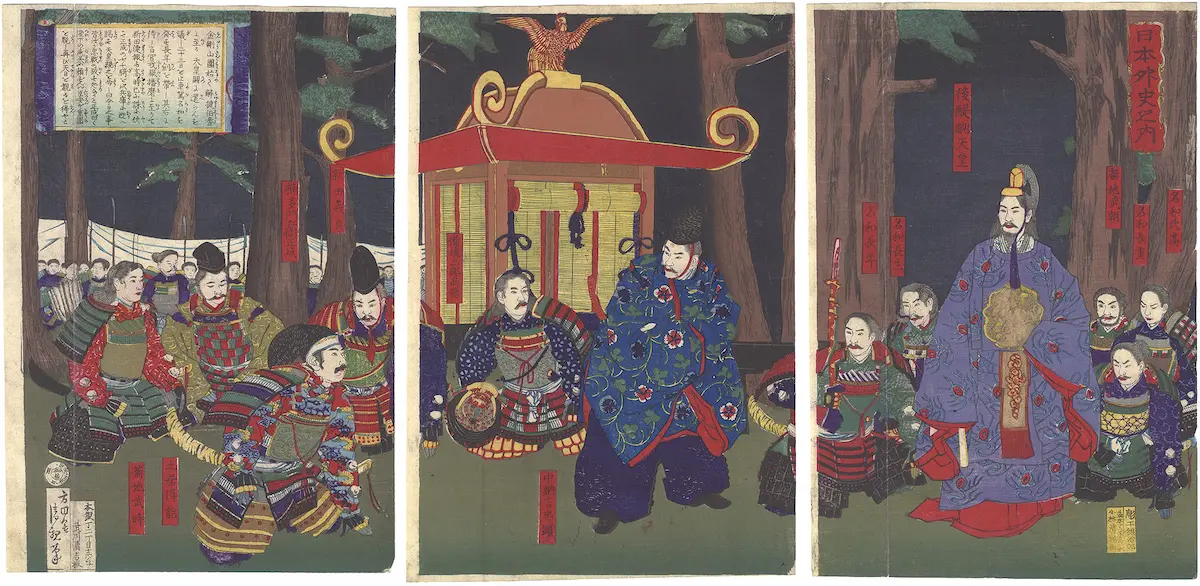The Kenmu Restoration, a significant yet brief period in Japanese history from 1333 to 1336, marked an attempt by Emperor Go-Daigo to restore imperial rule following the decline of the Kamakura Shogunate.
Initiated against a backdrop of political instability and warrior class discontent, Go-Daigo’s ambitious plan aimed at centralizing power and reducing military influence. It culminated in the Genkō War and the fall of the Kamakura Shogunate.
However, his failure to balance the interests of the samurai and court nobles, coupled with strategic and military missteps, led to his downfall.
Ashikaga Takauji, initially an ally, rebelled against Go-Daigo, decisively defeating his forces in the Battle of Minato River and establishing the Ashikaga Shogunate.
This marked the end of the Kenmu Restoration and ushered in the Muromachi period of Japanese history.
Key Takeaways
- The Kenmu Restoration represented a crucial shift in power. It marked the transition from the Kamakura Shogunate to the Muromachi period and a temporary resurgence of imperial authority under Emperor Go-Daigo.
- Go-Daigo aimed to centralize control and diminish military dominance. His vision was influenced by Chinese historical models, focusing on direct imperial rule.
- The emperor struggled to balance samurai and noble interests. His political and military strategies, particularly against Ashikaga Takauji, ultimately led to his downfall.
- Ashikaga Takauji’s rebellion signaled the end of the Restoration. His victory established the Ashikaga Shogunate and initiated the Muromachi period.
- The Kenmu Restoration was a defining moment in Japanese history. It was the last significant instance of imperial power until the Meiji Restoration in 1868.
Background of Kenmu Restoration
The Kenmu Restoration, or Kenmu no shinsei, marked a brief return to imperial rule between the Kamakura and Muromachi periods.
The Kamakura Shogunate, established by Minamoto no Yoritomo in 1192, marked the onset of a de facto military government in Japan. During this time, the imperial house was largely overshadowed by the military prowess and political influence of the shogunate.
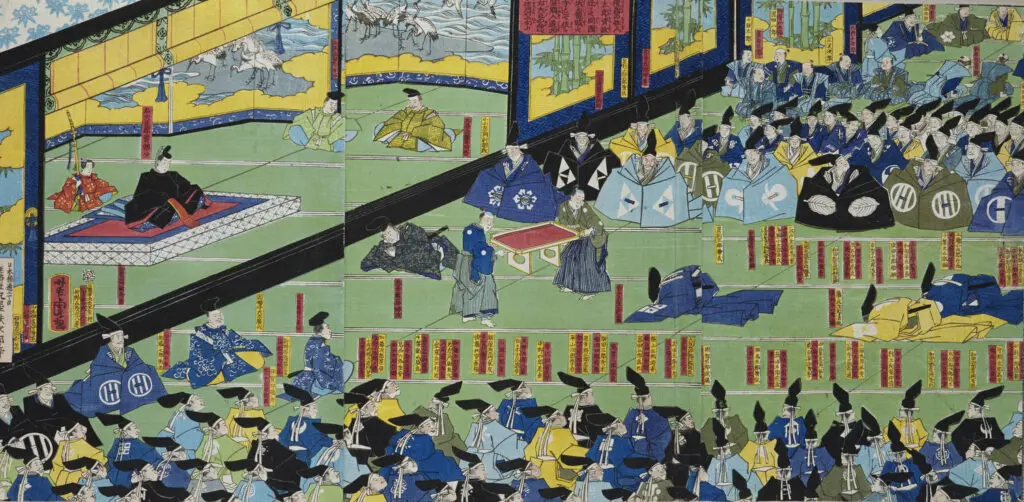
The Hōjō clan, under the shogunate, wielded considerable power, often outweighing the emperor’s authority. This period saw the emperor’s role being increasingly usurped by powerful military families, leading to a dual government where the emperor reigned but did not rule.
A critical development during this period was the establishment of the shugo (military governors) and jito (manor lords). This system granted military figures land and political autonomy, further diminishing the central authority of the emperor.
The shogunate’s involvement in imperial succession disputes, particularly after the Mongol invasions of Japan, led to a weakened and politically unstable situation.
This instability was marked by the creation of two rival imperial lines – the Jimyōin-tō (representing the Northern Court) and the Daikakuji-tō (representing the Southern Court) – and the shogunate’s decision to alternate succession between these lines.
This system, known as the “Divided realm with alternating successions,” created a scenario of two coexisting courts, each with its own emperor.
This backdrop set the stage for Emperor Go-Daigo’s ascent to the throne and his subsequent efforts to restore the power of the imperial house, leading directly to the events of the Kenmu Restoration.

Plan for the Kenmu Restoration
The Kenmu Restoration, initiated by Emperor Go-Daigo, was a strategic and determined effort to overthrow the prevailing Kamakura Shogunate and re-establish the importance of the imperial house in Japanese governance.
This ambitious plan was conceived against a backdrop of weakened shogunal power and growing dissatisfaction among various classes, particularly the warrior class, who felt marginalized.
Emperor Go-Daigo, ascending the throne in 1318, was not content with the ceremonial role typically assigned to the emperor in the dual polity of the time.
Influenced by his study of Confucian classics and Chinese history, he envisioned a Japan where the emperor would not only reign but also rule directly, breaking the cycle of military governments exemplified by the Kamakura Shogunate.
Central to Go-Daigo’s plan was establishing a government that would not rely on the military might of the shogunate. He surrounded himself with loyal ministers, notably Kitabatake Chikafusa, who were chosen for their merit rather than hereditary power, aligning with the ideal Chinese governance model. This new cadre of ministers was expected to maintain undivided loyalty to the emperor and provide sound advice, focusing on the greater good rather than familial or regional interests.
Economically, Go-Daigo sought to tap into Kyoto’s commercial potential, imposing taxes in traditionally exempt areas like sake brewing and certain temple domains. This was part of a broader strategy to strengthen the economic standing of the imperial court, making it less dependent on the military class.
The military aspect of Go-Daigo’s plan involved mobilizing samurai, particularly those from the Kanto and Kinai regions who were discontent with the Hojo’s rule and the slim rewards following the Mongol invasions. This mobilization aimed to capitalize on these warriors’ growing resentment towards the shogunate. Go-Daigo’s strategy was to present himself as a unifying figure for these dissatisfied elements, offering a vision of a restored imperial rule to address their grievances.
However, Go-Daigo’s plans faced early setbacks, notably in the Shōchū Incident of 1324, where his initial attempts at undermining the shogunate were thwarted. Despite this, his resolve did not waver. He continued to plot the downfall of the Hōjō clan and the Kamakura Shogunate, leading to the eventual outbreak of the Genkō War, a crucial step in his campaign for restoration.
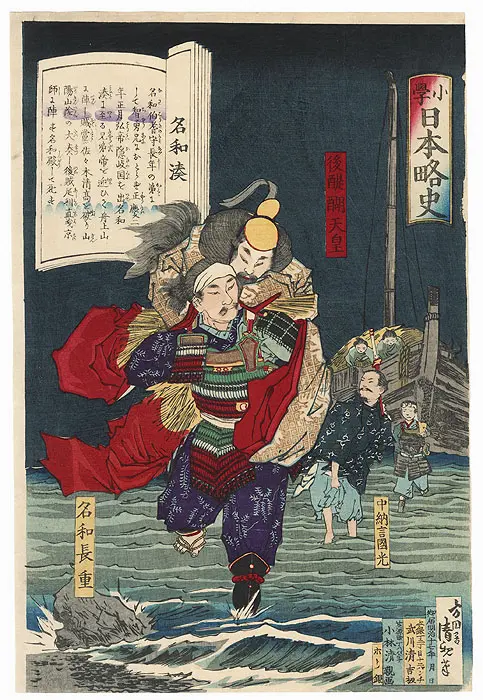
Key Events during the Restoration
The Genkō War and the Fall of the Kamakura Shogunate
In 1331, Emperor Go-Daigo, leveraging discontent among samurai and other allies dissatisfied with the Kamakura Shogunate, orchestrated a widespread rebellion.
This war, marked by various battles across Japan, culminated in 1333 with the siege of Kamakura by Go-Daigo’s ally, Nitta Yoshisada. Yoshisada’s successful siege and the subsequent wipeout of the Hōjō clan marked the end of the Kamakura Shogunate and paved the way for the Kenmu Restoration.

Establishment of the Kenmu New Government
Following the victory in the Genkō War, Emperor Go-Daigo returned to Kyoto. He began the process of establishing the Kenmu New Government. Central to this was the creation of administrative bodies intended to centralize power and reduce the influence of the warrior class.
This phase represented a significant shift in power from the military government to the imperial court, a change not seen before the shogunate’s establishment.
The Rise of Ashikaga Takauji
A critical turning point in the Kenmu Restoration was the rise of Ashikaga Takauji. Initially an ally of Emperor Go-Daigo and a key figure in overthrowing the Kamakura Shogunate, Takauji’s allegiance shifted dramatically in 1336.
Discontented with the emperor’s policies, which favored the court nobility over the samurai class, Takauji rebelled against Go-Daigo, significantly altering the power dynamics of the period.
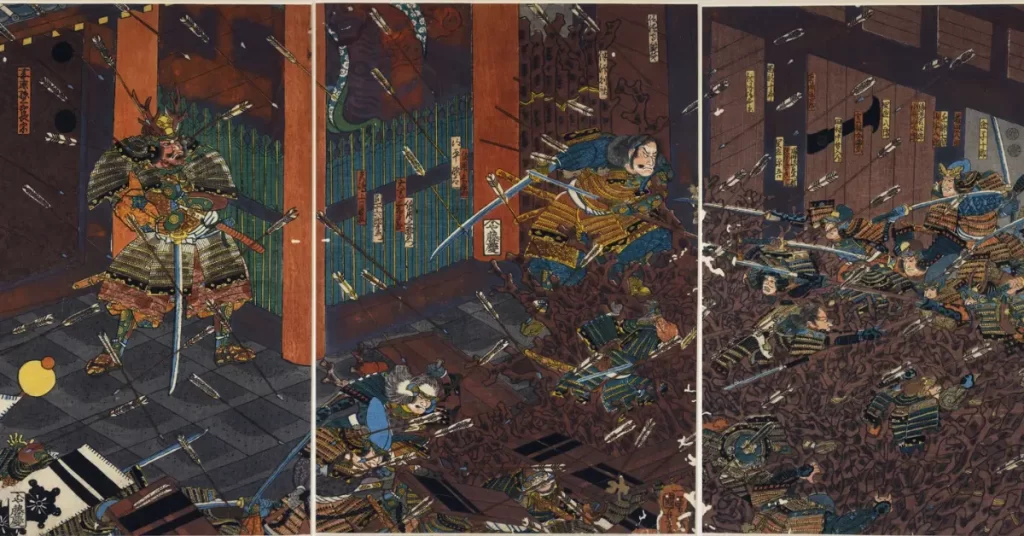
Battle of Minato River
The Battle of Minato River was decisive and tragic. This battle saw Ashikaga Takauji’s forces clash with those loyal to Emperor Go-Daigo.
The emperor’s forces, led by loyalists like Kusunoki Masashige and his brother, suffered a devastating defeat.
The aftermath of the battle, including the suicides of Masashige and his brother, symbolized the waning power of Go-Daigo and the impending end of the Kenmu Restoration.
These events demonstrated the tumultuous nature of the Kenmu Restoration, a period marked by swift changes in power, intense military confrontations, and a continuous struggle for supremacy between the imperial court and the warrior class.
Emperor Go-Daigo’s Challenges and Failures
Emperor Go-Daigo’s reign during the Kenmu Restoration faced significant challenges and witnessed notable failures, ultimately leading to the collapse of his ambitious plans to restore imperial rule.
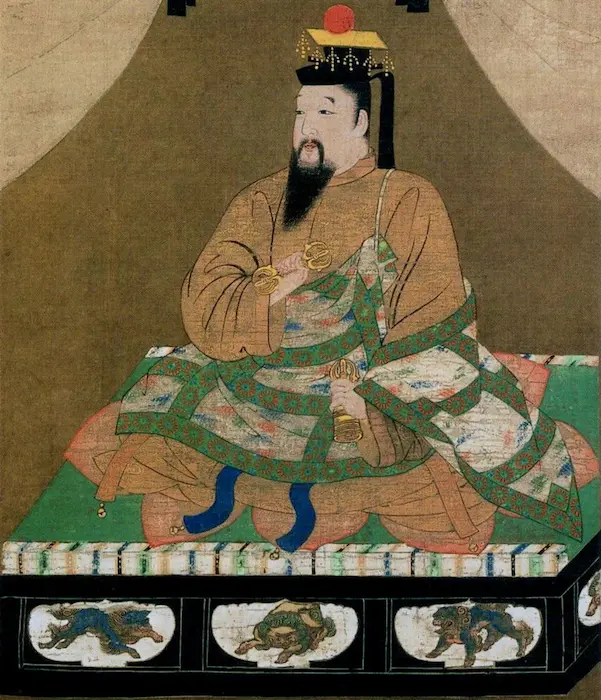
Political and Economic Missteps
One of the key challenges Go-Daigo faced was his inability to balance the interests of the various social classes, especially the samurai.
While he sought to centralize power and reduce the influence of the military class, his policies disproportionately favored the court nobility in Kyoto. This approach alienated the samurai, who felt sidelined and unrewarded despite their crucial role in overthrowing the Kamakura Shogunate.
For instance, Go-Daigo failed to redistribute the confiscated lands of the Hōjō clan effectively, leading to dissatisfaction among the samurai who had expected rewards for their support.
Economically, Go-Daigo’s interventions in commercial affairs and imposition of new taxes, such as on sake brewers and residents in temple areas, were seen as overreaching.
These measures, intended to strengthen the imperial court’s financial base, ended up causing resentment among the affected groups.
Military Challenges
While initially successful in overthrowing the Kamakura Shogunate, Go-Daigo’s reliance on a small group of loyalists proved inadequate in the face of the larger and better-organized forces of the Ashikaga clan.
The Battle of Minato River in 1336 was a critical military failure, where his forces, despite the valiant efforts of Kusunoki Masashige and others, were decisively defeated by Ashikaga Takauji’s army.
This defeat significantly weakened Go-Daigo’s position and control over the country.
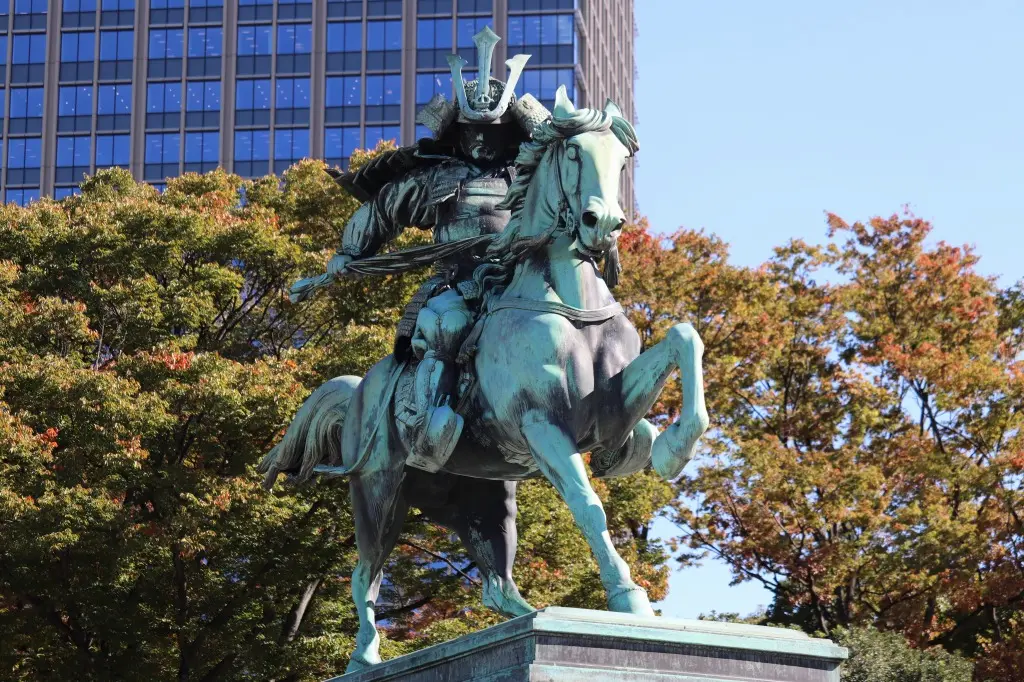
Mismanagement of Alliances
Go-Daigo’s management of crucial alliances also contributed to his downfall. His inability to maintain the support of Ashikaga Takauji, a pivotal figure in the initial stages of the Restoration, was a significant setback.
Takauji’s defection and subsequent rebellion in 1336 divided the imperial forces and provided a solid and organized opposition to Go-Daigo’s rule.
Internal Court Politics
Internally, the court politics under Go-Daigo’s rule were fraught with inefficiencies and corruption. The tribunals set up to redistribute lands were plagued by ineffectiveness and bribery, further alienating the samurai class.
Additionally, Go-Daigo’s efforts to reward religious institutions and his favoritism towards specific individuals led to a perception of bias and mismanagement.
The End of the Kenmu Restoration
The Kenmu Restoration, a period of ambitious imperial resurgence under Emperor Go-Daigo, ended abruptly due to a confluence of military, political, and social factors.
The Rise of Ashikaga Takauji
A critical factor in the demise of the Kenmu Restoration was the rebellion led by Ashikaga Takauji, a former ally of Go-Daigo.
Takauji’s defection in 1336, driven by dissatisfaction with Go-Daigo’s policies and his favoritism towards the court nobles, signaled a major shift in the power dynamics.
Takauji, leveraging his military prowess and support among the samurai, quickly captured Kamakura, establishing a base of power that directly challenged the emperor’s authority.
Division of the Imperial Court
Following these military setbacks, Go-Daigo fled southward to Yoshino, leading to the establishment of the Southern Court.
Meanwhile, Ashikaga Takauji, consolidating his power in Kyoto, placed Emperor Komyo from the Senior Line on the throne, effectively creating a division in the imperial court with the Northern Court in Kyoto and the Southern Court in Yoshino.
This division, lasting until 1392, symbolized the fractured nature of Japanese politics and the definitive end of the Kenmu Restoration.
Establishment of the Ashikaga Shogunate
In the aftermath of these events, Ashikaga Takauji established the Ashikaga Shogunate in 1336.
This new shogunate marked the beginning of the Muromachi period in Japanese history. Takauji’s ascent to power represented the end of the Kenmu Restoration and a return to military-dominated governance, albeit under a new regime.
The Legacy of the Kenmu Restoration
The Kenmu Restoration, although short-lived, left a significant legacy. It was the last time the Emperor of Japan held significant power until the Meiji Restoration in 1868.
Frequently Asked Questions
When did the Kenmu Restoration occur?
The Kenmu Restoration occurred from 1333 to 1336.
What was the Kenmu Restoration about?
It was an effort by Emperor Go-Daigo to restore imperial rule in Japan, ending the Kamakura Shogunate and reducing the power of the military class.
What led to the failure of the Kenmu Restoration?
The failure resulted from Emperor Go-Daigo’s inability to balance the interests of samurai and nobles, coupled with strategic military defeats, especially against Ashikaga Takauji.
How did Ashikaga Takauji become shogun?
After rebelling against Emperor Go-Daigo and defeating his forces, Ashikaga Takauji established the Ashikaga Shogunate, becoming shogun and initiating the Muromachi period.
Further Readings
- The Cambridge History of Japan: Volume 3 (Medieval Japan)
- A Concise History of Japan by Brett L. Walker

